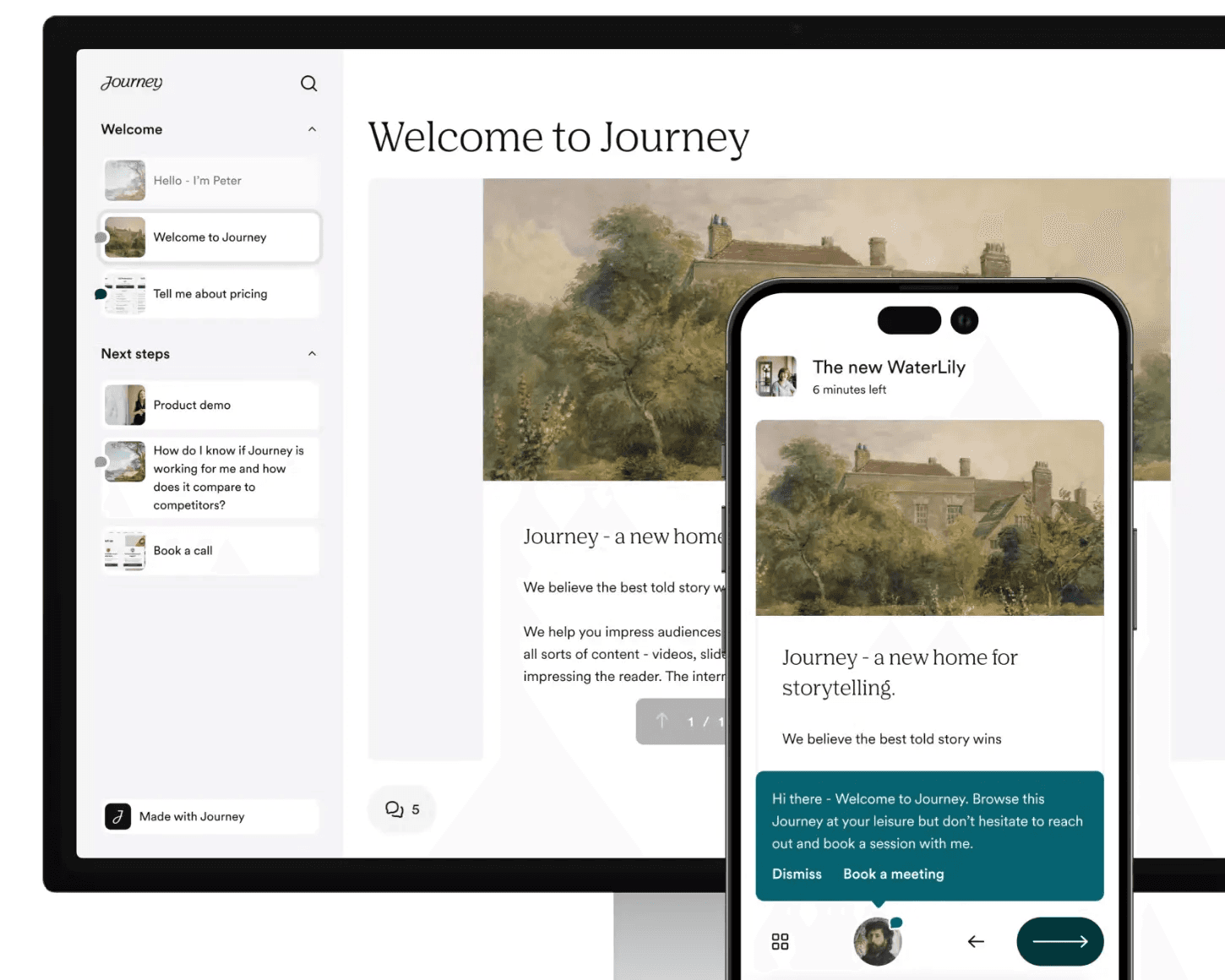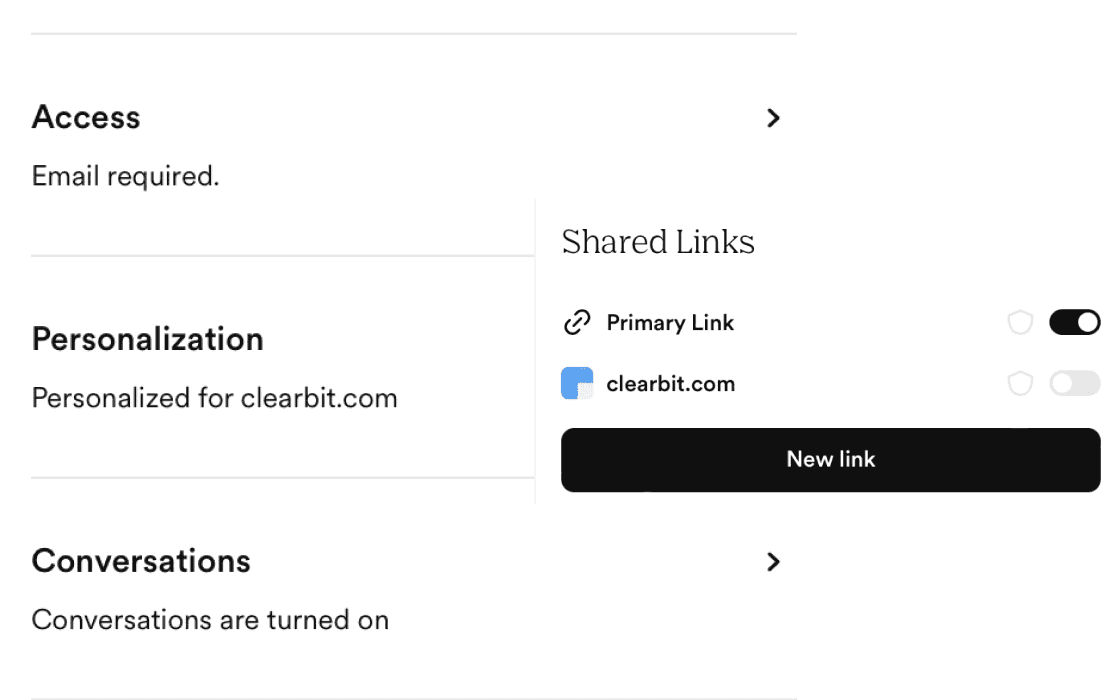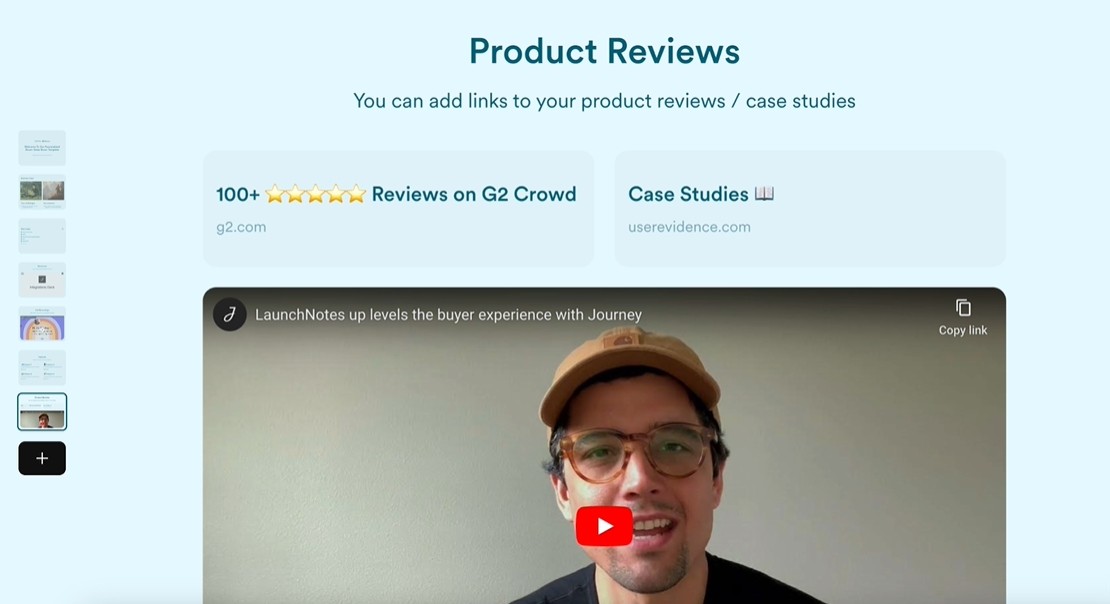March 28, 2024

2024 is shaping up to be a transformative year. However, given the hype around AI, it might sound surprising that the human touch remains essential in our roles.
So, in this article, we’ll distill cutting-edge sales trends for 2024, from digital sales rooms to data privacy.
Ready? Let’s dive in!
Artificial Intelligence (AI) Trends in 2024 Sales, of Course
If you're in sales, you understand the pressing need to streamline tasks without compromising quality. Not to mention, you'd probably shed a tear or two if you were suddenly stripped of tools like ChatGPT (or whichever GPT-based tool you use). It's astonishing to think back to a time when we managed everything manually.
The drive to speed up processes stems from a desire to allocate more time to the tasks that truly demand our attention – like engaging with customers directly or handling specific cases without being bogged down by time constraints. AI has been helping us tremendously with that, and the tendency is for it to get better and smarter.
According to HubSpot, 81% of professionals attest to the “time-saving benefits, efficiency gains, and enhanced personalization” of AI tools.
These technologies do their best work when supporting B2B sales reps in their daily multiple-stakeholder endeavors. This results in deeper customer engagement, as sales professionals no longer have their hands full and can pay full attention to each target account.
Take automated note-taking, for instance. It loosens the burden on salespeople by transcribing client chats, sparing them the need to hire external writers or grapple with manual transcription.
And, instead of sifting through hours of call recordings, sales managers can use conversational intelligence like Gong.io’s sales enablement tool to pinpoint opportunities and glean insights from their customers after a call. During the call, they can focus on the usual human stuff. Eye contact. Connection. The things we’ve been growing a bit distant from.

Source: Gartner
Speaking of which, here’s something that’ll make you feel like you’re in Blade Runner 2049:
It's projected that by 2025, 35% of CROs will integrate a centralized "GenAI Operations" team into their go-to-market strategy. This evolution may sound too far ahead from what we’re used to, but it’ll soon become standard.
“Before generative AI, sellers would review disparate data sources to inform their tactics and messaging. Generative AI will enable sales leaders to streamline these processes, saving hours of seller time.”
Adnan Zijadic, Director Analyst in the Gartner Sales Practice
Shorter Sales Cycles in 2024
Self-service when browsing products is nothing new. Even in brick-and-mortar stores, customers would rather explore on their own, without feeling pressured by hovering salespeople ready to pounce with a pitch at every turn.
As Journey user and CEO of CoachEm Colum Lundt aptly put it, prospects want the freedom to learn independently and only engage with a salesperson when they're truly ready or in need of assistance.
“We don't want to lose – or we don't want to discount – the nimbleness that a Product-Led Growth (PLG) process provides, where people can get ‘hands on keyboard’ and they can explore the product. So we still want to allow people to do that within the structure of an enterprise sale. And so what Journey allows us to do is to facilitate or accommodate that buying process.”
Buyers have been taking charge of their own learning for some time, but what's different in 2024 is the way AI has powered up their research efforts. This trend also influences your stakeholders, who are often already well-informed about your company before even engaging.
Here’s a twist for you: despite this wealth of previously attained knowledge, the sales process now demands more touchpoints.
Rarely does a sale happen at the first contact. Instead, it's a journey requiring multiple interactions. The concerning gap is…the average salesperson typically makes only two attempts to reach a prospect. This needs to change. Adopt a multi-touch approach to nurture quality relationships, as highlighted in HubSpot's 2022 Sales Strategy & Trends Report.

Source: Sourcery Academy
A third of sales reps report averaging 2-4 interactions with prospects, while 26% report 5-7 interactions, which may sound like a lot. But it’s not: despite the need for more touchpoints, increased knowledge often leads to shorter sales cycles. This is, if you will, a fascinating paradox in modern sales.
While the number of touchpoints and interactions may increase, their focus shifts to what truly matters to customers. It's no longer a dull debate between benefits and features. Instead, conversations can center on personalized topics built for the buyer's specific needs and use cases.
Engaged, Humanized Interactions
Prospects are hesitant to engage with salespeople upfront – often delaying contact to avoid negative experiences or pushy tactics – so salespeople have started transitioning into “relationship builders.”
That means they can better guide prospects through a process of discovery rather than bombarding them with unnecessary product details.
With buyers taking the lead in educating themselves, sales professionals adapt by becoming trusted advisors, using the prospect's existing knowledge to drive deals forward.
The key now lies in having high-quality conversations that address individual concerns and align product offerings with what customers are looking for, best executed by using the Sandler pain funnel conversation guidance.
By focusing on building trust and rapport (real trust and rapport – not a brief interest-ridden blurb so you can “shoot your shot”), salespeople pave the way for relationships grounded in mutual understanding.
Multi-Channel Sales in 2024
By the way, what’s your average screen time? Chances are, you're juggling several apps throughout the day. Whether you're sending texts, scrolling through social media, or listening to podcasts while multitasking, smartphones have become part of our bodies.
But amidst the digital humdrum, one thing remains clear: consumers crave personalized experiences no matter what or where. According to recent data, 66% of consumers would "quit a brand if their experience isn't personalized," a figure that jumps to 75% among Gen Z audiences.
This underscores the importance of adopting a multichannel sales strategy. By meeting customers where they are across various channels, companies can expand their reach, enhance brand visibility, and ultimately drive revenue growth.
Here’s an example:
Imagine a water bottle salesman positioned strategically at the end of a running track. If he's not present where potential customers are, he's missing out on valuable opportunities. The key is not to be everywhere at once but to be in the right places at the right time, both online and offline. By strategically selecting the most effective channels to engage with customers, businesses can create a timely presence without having to app-hop.
The ultimate goal is understanding where your potential customers “live” and ensuring your presence is felt there. Of course, that requires gathering and analyzing data about your audience to inform your marketing and sales efforts.
But, speaking of data…privacy is another growing concern. We all believe it's essential to handle personal data with care and respect, but few of us put that belief into practice. In 2024, safeguarding user privacy is a moral imperative for businesses seeking to earn (and keep!) customer trust.
Here’s a deeper dive:
Information and Data Privacy
Privacy isn’t just about dismissing cookies. With the constant shuffle between websites, platforms, and apps, it's only natural to feel a bit uneasy about how our personal information is being handled.
87% of consumers say they'd steer clear of companies they're not sure about when it comes to data security. Despite the push for transparency, a hefty 67% of users admit they're pretty much in the dark about how their data gets used – not exactly reassuring.
Plus, it's not just users worrying about privacy. Companies are feeling it, too. In 2023 alone, fines for GDPR violations topped 2 billion euros, as Statista reports.
With more people cluing to the importance of data privacy, governments are enforcing more regulations like GDPR this year. These rules may sound like cybersecurity jargon, but they're the only way to make sure your customers’ privacy rights are taken into account and you’re playing fair with their data.
Offering Your Product as the Ultimate Solution to Pressing Problems through Storytelling
Consider the stories that have left a lasting impact on you. They resonated because they tapped into your emotions and mirrored your experiences. It's no surprise then that the authors you enjoy are the ones who can connect with you on a deeper level.
Prospects don’t care how a product works. They want assurance that their needs are understood, their requirements are addressed, and the product will make their lives better.
You can’t give that assurance unless you guide them through it. It’s storytelling at its best.
(That doesn’t mean you shouldn’t include your product’s features on your sales decks! It just means they shouldn’t be the star of the show. Unless you have data to confirm that all your prospects need is a quick feature checklist.)
It all comes down to stories. People want to see themselves reflected in the narrative and understand how your product aligns with their current way of doing things. Simply hitting them with technical details isn't enough anymore – they've likely heard it all before.
Similarly, you can't just poke at a wound and walk away. You need to offer the cure. Don’t settle for merely understanding the challenges prospects face. Demonstrate how your solution addresses each of those pain points.
As you know, the conundrum in B2B sales lies in the fact that what resonates with one prospect may not necessarily work for another. It's a delicate balance of understanding individual needs – and meeting all of them.
So, how do you do it?
Digital Sales Rooms Help You Adapt to 2024 Sales Trends
Digital sales rooms are an everything-hub for the long-winded, multifaceted B2B buying journeys you’re familiar with. (They’re particularly useful as you're dealing with more stakeholders than you'd care to count.)
To handle all these moving parts (and people), you've got to approach each stakeholder like a consultant would. And because each stakeholder is so different from the next, even the best multitaskers would find that challenging.
That's where Journey’s digital sales rooms step in, making all the puzzle pieces fit together.
Journey Gives You a Central HQ to Convince Every Stakeholder

One link is all it takes to make sure everyone is well-fed with the right data, at just the right time.
Whether it's the CEO craving ROI statistics, the product managers seeking UX validation, or the sales managers hungry for insights on closing deals, you've got them all covered.
With your favorite tools available for integration with Journey, you're all set to handle different demands without needing to clone yourself. Imagine the chaos of juggling multiple proposals via email, LinkedIn, and elsewhere. It's a recipe for missed opportunities.
Multi-channel engagement isn't about stretching yourself thin. Instead, it’s about being wherever your customers are. But to pull it off smoothly, you've got to understand each stakeholder's needs to steer the deal in the right direction.
Otherwise, you'll be caught in a tug-of-war where a few of your stakeholders hold a clear advantage. More friction, more headaches. Let's avoid that.
Journey.io’s Approach to Data Privacy in 2024 Sales

When it comes to managing access to your Journey, you've got options to suit your needs. Start by defining who's in and who's out with “Allow and Deny” lists.
With these lists, you can decide which email addresses or domains get the green light or the red flag.
Need an extra layer of security? No problem! Implement passcodes and verification. Whether it's requiring a passcode for entry or validating email addresses with a simple click, you've got the tools to keep things locked down tight.
And above all, you can also control the Journey itself. Set expiration dates, establish default access controls, and tweak settings to fit your preferences perfectly. With these features seamlessly blended, managing access allows you to focus on what matters most – delivering an exceptional experience. Yes, for all the stakeholders involved.
Get Actionable Sales Data to Speed up Your Velocity

Sales is all about understanding people. Even then, typical customer-focused data points only scratch the surface.
So, how do you dig deeper?
Imagine having to interview each stakeholder about their experience in your digital sales rooms. Thankfully, you don’t need to go through all that to get the data you need.
With real-time analytics, Journey helps you effortlessly track stakeholder interactions. No need for awkward interviews. Instead, receive instant notifications via Slack or email detailing who viewed your Journey, how many times, for how long, and when they exited.
Plus, with live chat functionality, you can address any queries they have as they move along for a seamless experience. Even if a deal falls through, the customer insights you glimpse help you refine your sales approach for future opportunities. So you can close the next deal, and the one after that.
Most Importantly, Journeys Give Stakeholders the Humanized Sales Experience They Desire

Most importantly, digital sales rooms return the human touch to sales.
As AI becomes “the norm”, our desire for authentic human interactions grows stronger. We end up missing out on valuable opportunities to engage with customers when they truly need us.
That’s why, when selecting a tool to streamline your processes, opt for one that doesn't neglect the human element but rather embraces it.
Look for a solution that enables meaningful interactions with stakeholders as they navigate through their journey. Be there for them when they need your help and expertise, not after they've already made a decision elsewhere.
Finally, choose a solution that taps into the fundamental aspect of human life: storytelling. Every Digital Sales Room has a story to tell, woven through the combination of your sales collateral. These narratives not only persuade prospects to choose you but also inspire them to stay with you.
“Journey.io simplifies storytelling, customer engagement, and deal closure by offering a single, powerful link for all these purposes. It makes sharing stories, managing interactions, and finalizing deals easier and more efficient, ultimately saving time and improving outcomes.”
Trisha Paras, Journey User
Outcomes such as…
In 2024, choose Journey.

